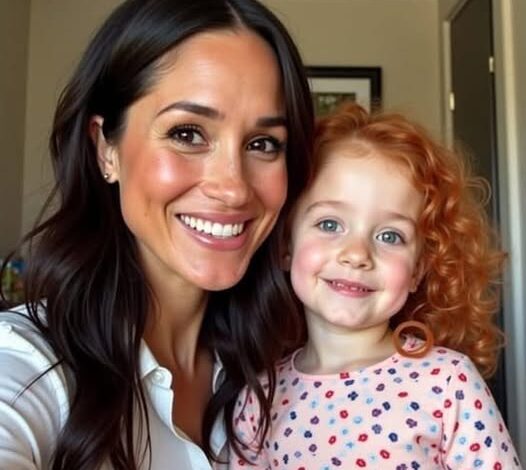
Meghan Markle caught the UK off guard when she posted the first publicly shared photo of her four-year-old daughter, Lilibet Diana. For a couple that has fiercely guarded their children’s privacy since stepping back from royal duties, the sudden openness came as a genuine surprise — and it immediately set social media on fire. Within minutes, the image spread across every major platform, dominating headlines and sparking conversations from London cafés to California living rooms.
The photo itself didn’t rely on theatrics. It was simple, soft, and natural — and that’s exactly why people reacted so strongly. Lilibet stands in a sunlit garden, her small hand wrapped around a bunch of fresh daisies. The lighting is warm, almost nostalgic, brushing across her pale dress and catching the red strands of her hair. There’s a quiet charm in the composition, the kind of image that doesn’t try too hard, yet says more than any official portrait ever could.
Meghan’s caption was what really set the tone. She wrote about Lilibet as a symbol of “love and strength,” a phrase that felt intentionally chosen. It gave the photo emotional weight without turning it into a spectacle. For a family that has spent years navigating public scrutiny, criticism, and endless speculation, the words carried a sense of grounding — a reminder that behind the headlines and noise, there’s a family simply trying to live its life.
And that’s where the public reaction became fascinating. The UK — often divided in its feelings toward Meghan and Harry — responded with a mix of surprise, reflection, and even warmth. People who typically tear apart every Sussex headline suddenly paused, softened, and found themselves admiring a moment of ordinary beauty. The photo didn’t feel strategic. It felt human.
Many noticed how much Lilibet resembles her father. The unmistakable red hair, the soft expression, the gentle smile — traits that run deep in the family line. Some compared her to Harry as a child; others pointed out fleeting echoes of Princess Diana. These observations had nothing to do with controversy or debate. They came from a place of nostalgia, the kind of collective memory that binds generations together.
What struck people most was the fact that Meghan and Harry chose to share this moment at all. Since moving to California, they’ve been careful — even protective — about shielding their children from the public eye. It wasn’t a secret and it wasn’t complicated: they wanted their kids to grow up with normalcy, something they themselves didn’t have. That’s why this post felt so deliberate. It wasn’t random. It wasn’t impulsive. It was intentional.
For some royal watchers, this act of openness hinted, however subtly, at a possible thaw in the tension between the Sussexes and the rest of the royal family. Whether that interpretation is hopeful or simply imaginative doesn’t change the fact that people wanted to believe it. The UK has always had a complicated relationship with the couple, but this photo managed to cut through the static. It reminded people that beyond disagreements, protocols, and public drama, children remain innocent threads that tie families together.
The serene setting of the photo added to this narrative. It didn’t appear overly staged or excessively curated. It looked like a real moment — sunlight filtering through the leaves, a child holding wildflowers, the natural ease of a candid capture. People connected with that authenticity. For once, the story wasn’t about tension, criticism, or speculation. It was about a child, growing, laughing, living her life.
The response didn’t stay confined to fans. Celebrities, public figures, photographers, and even media personalities reacted positively. Some praised Meghan’s photography skills. Others commended the couple for choosing to share something meaningful rather than polished. The warmth of the reaction cut across the usual tribal lines of royal commentary.
But perhaps the most interesting element wasn’t public praise — it was the shift in tone. Conversations moved from “What are they doing now?” to “Look how big she’s gotten,” “She has her dad’s hair,” and “She looks so carefree.” The discourse became less about the Sussex narrative and more about the small, universal beauty of childhood.
And in that softness, people found themselves reflecting on how quickly time passes. Many remembered when Lilibet’s birth was first announced. Others recalled the early debates about whether she would ever be seen in public. For those who’ve followed the royal family for decades, this photo became a reminder that even in complicated families, children grow, life moves forward, and milestones happen whether the world is watching or not.
Of course, the photo also sparked conversations about privacy. Some wondered if this marked a new era for Meghan and Harry — a more open approach. Others believed it was a one-time exception, a rare moment they felt comfortable sharing. What seemed clear was that this wasn’t a return to traditional royal visibility. It was a controlled, personal decision made on their own terms.
And that’s exactly why it resonated. Not because it was polished. Not because it was royal. But because it was real.
The UK, despite its ongoing debates about Meghan and Harry, paused long enough to appreciate something genuine. A mother sharing a picture of her daughter. A father’s unmistakable features reflected in a child. A connection to a grandmother gone too soon. A fragile sense of unity in a story that usually sparks division.
One photo — not a statement, not an interview, not a documentary — managed to remind people that behind every headline is a human family trying to protect its peace. And for a brief moment, the world let them.
If you want, I can expand it, sharpen the tone even more, make it more dramatic, or shape it to fit a specific publication style.